Oct 24
Posted: under Activities, photography.
Tags: Activities, beauty, dragonfly, native plants, photography October 24th, 2009
We have a new species for the list, another bug (literally bug–a stinkbug found on a bush honeysuckle yesterday morning.) There were lots of them, in fact: all adults, this time. (You can tell by the wings folded onto the back.) [...more]
We have a new species for the list, another bug (literally bug–a stinkbug found on a bush honeysuckle yesterday morning.) There were lots of them, in fact: all adults, this time. (You can tell by the wings folded onto the back.)
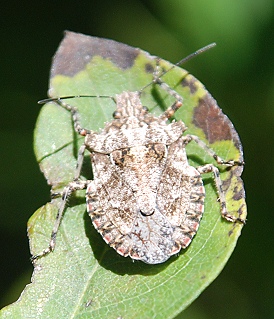
Read the rest of this entry »

Sep 08
Posted: under Activities, photography, Water, Wildlife.
Tags: Activities, photography, water resource management, wildlife management September 8th, 2009
One of the main activities for wildlife managers in Texas is providing supplemental water for wildlife. Where natural water supplies are abundant and unpolluted, supplemental water may not be necessary, but drought years come to all regions, and wildlife suffer if they do not have access to a reliable, safe, supply of water. In a […] [...more]
One of the main activities for wildlife managers in Texas is providing supplemental water for wildlife. Where natural water supplies are abundant and unpolluted, supplemental water may not be necessary, but drought years come to all regions, and wildlife suffer if they do not have access to a reliable, safe, supply of water.
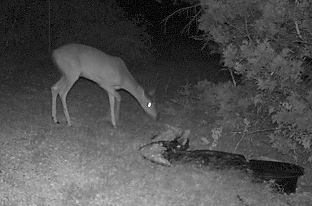
In a drought summer, with all natural water gone, deer made regular use of this small, three-tub water on a rocky knoll. Because of its small size, this waterer needed daily filling through the summer. A small solar-powered pump in the lowest tub circulates the water.
When considering water for wildlife, it’s important to set up a system for reliable (constant) water that is safe for wildlife to use and is provided in containers that allow access by a wide range of wildlife. This means thinking about the water source (rainwater, well water, stored surface water), water quality, and the shape, size, and location of water presentation.
Read the rest of this entry »

Aug 31
Posted: under Activities, Wildlife.
Tags: Activities, Animal behavior, photography, reptile behavior, wildlife management August 31st, 2009
Several times in the past couple of years we’ve had to get a turtle out of the fence. The horse lots fencing is pipe with welded-mesh cattle panels welded to the pipe–so there’s a pipe at the bottom. Good safe horse fence, but not easy for turtles to maneuver through/around and turtles don’t seem to […] [...more]
Several times in the past couple of years we’ve had to get a turtle out of the fence. The horse lots fencing is pipe with welded-mesh cattle panels welded to the pipe–so there’s a pipe at the bottom. Good safe horse fence, but not easy for turtles to maneuver through/around and turtles don’t seem to have the idea of paralleling a fence to find a gap.
So yesterday evening, shortly before dark, the horses were acting freakish in the barn and south barn pen, and Richard spotted a good-sized turtle. I came out with the camera and first saw this:
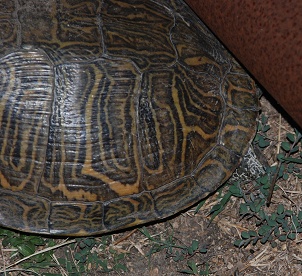
Read the rest of this entry »

Jun 22
Posted: under Activities, Water.
Tags: Activities, water resource management June 22nd, 2009
We happen to be in a county that chose to emphasize development over conservation, which has resulted in a water shortage here even greater than the climate would cause on its own. (It’s ironic that the best-known history of the county is titled Land of Good Water.) For those whose county governments haven’t yet destroyed […] [...more]
We happen to be in a county that chose to emphasize development over conservation, which has resulted in a water shortage here even greater than the climate would cause on its own. (It’s ironic that the best-known history of the county is titled Land of Good Water.)
For those whose county governments haven’t yet destroyed their water resources…here’s how it worked in our case.
Read the rest of this entry »

Jun 19
Posted: under Activities, photography, Wildlife.
Tags: Activities, beauty, identification, insect, new species, photography June 19th, 2009
I mentioned back a few posts that May 23, the day of the weird beetle in the bathroom, had also produced a weird moth in the kitchen…and I forgot, until I was at BugGuide looking at some of my images to see if something “new” was really “old”, that May 23, also produced the pretty […] [...more]
I mentioned back a few posts that May 23, the day of the weird beetle in the bathroom, had also produced a weird moth in the kitchen…and I forgot, until I was at BugGuide looking at some of my images to see if something “new” was really “old”, that May 23, also produced the pretty spot-winged fly on the skeleton plant flower.
Now that I have an ID for the moth, a Yellow-fringed Dolichomia, Dolichomia olinalis I think, though mine was larger than the typical size listed.
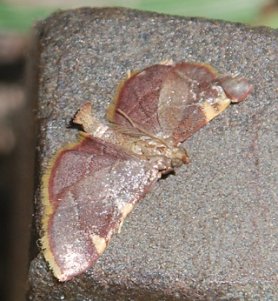
The contrast of the distinctly rosy-brown, glossy wings with their subtle patterns and the dull-yellow fringe is beautiful. The larvae feed on oak trees, and since we have oak trees of several species, I’m fairly confident this moth is reproducing here.
Read the rest of this entry »

Jun 13
Posted: under Activities, photography, Wildlife.
Tags: Activities, beauty, documentation, identification, insect, odonates, photography June 13th, 2009
Besides the pretty pictures aspect (and I enjoy the pretty pictures, both taking them and seeing them online), photography has multiple uses that support wildlife and land management. For instance…I’m almost at the pond and a weakly-flying near-dragonfly-sized insect flies up and lands on the underside of a small limb. I can’t, with my eyesight, […] [...more]
Besides the pretty pictures aspect (and I enjoy the pretty pictures, both taking them and seeing them online), photography has multiple uses that support wildlife and land management. For instance…I’m almost at the pond and a weakly-flying near-dragonfly-sized insect flies up and lands on the underside of a small limb. I can’t, with my eyesight, see it clearly. I know it’s not a dragonfly, butterfly, or moth, but what is it? If I get too close it will fly away.
Enter the camera with a zoom lens:
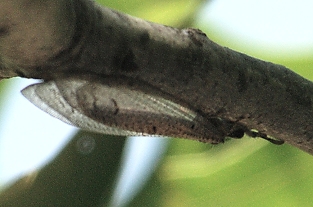 Read the rest of this entry »
Read the rest of this entry »

Jun 12
Posted: under Activities, Plantlife.
Tags: Activities, water resource management June 12th, 2009
Because there’s no permanent natural water on our place, the main aquatic habitat we can provide for wildlife is near the house (where, if we don’t collect enough rainwater, we can use city water–in fact, the water garden began with city water supply.) It has an upper, stream-like section (small pools with low “falls” into […] [...more]
Because there’s no permanent natural water on our place, the main aquatic habitat we can provide for wildlife is near the house (where, if we don’t collect enough rainwater, we can use city water–in fact, the water garden began with city water supply.) It has an upper, stream-like section (small pools with low “falls” into each other, all in the shade) and a bottom pool that’s a 10×20 foot lily pond–with wide shallow ledges around the edge and a deep “trench” in the middle for the lilies.
To provide some vertical plantlife for dragonflies, damselflies, and other insects that need emergent vegetation, we added in pickerelweed and water iris. The water iris turned out to be very aggressive. Periodically we have to cut it back, and that’s a huge chore.
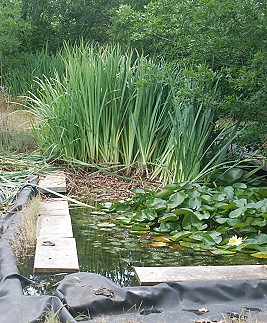
Read the rest of this entry »

Jun 04
Posted: under Activities, Plantlife.
Tags: Activities, beauty, land management, native plants, prairie restoration June 4th, 2009
If land managers had ten thousand years to play with the land, prairie restoration would be a lot easier, even if they had to start with an overgrazed, eroded, compacted, heavily-invaded, polluted mess. But we don’t. So some basic principles have been laid down–initially during research on northern prairies–that now govern most prairie restoration projects: […] [...more]
If land managers had ten thousand years to play with the land, prairie restoration would be a lot easier, even if they had to start with an overgrazed, eroded, compacted, heavily-invaded, polluted mess. But we don’t. So some basic principles have been laid down–initially during research on northern prairies–that now govern most prairie restoration projects: physical removal of invasive woody plants by fire (cheap) or various mechanical clearing methods (more expensive) , grazing management to interrupt succession, physical disturbance of the soil (discing, for instance) to induce germination of dormant seeds.
Read the rest of this entry »

Feb 13
Posted: under Activities, Wildlife.
Tags: Activities, bird behavior, census February 13th, 2009
The annual GBBC sponsored by Cornell University and the Audubon Society is our big bird census activity of the year. Usually I spent 1-2 hours in each of four sites on the land, but this year (since I’m under orders not to overdo as I recover from pneumonia) today’s observations at least will all be […] [...more]
The annual GBBC sponsored by Cornell University and the Audubon Society is our big bird census activity of the year. Usually I spent 1-2 hours in each of four sites on the land, but this year (since I’m under orders not to overdo as I recover from pneumonia) today’s observations at least will all be literally “yard” ones. So far that’s only eleven species….but my “special bird” in the year, the female Pyrrhuloxia, is still here. (Usually I see a really interesting bird the day before the count starts, and then not again until afterwards.)
Anyone who’s never participated should consider doing so…it’s fun and it contributes useful information on bird distribution in winter. There are maps, updated constantly, showing where observations have come from.

Feb 13
Posted: under Activities, photography, Plantlife.
Tags: Activities, drought, photography February 13th, 2009
Even in a dry year, spring comes early to central Texas. I’m recovering from pneumonia so can’t get out to the full 80 acres, but here are some pictures from around the house. (I need to plant some elbowbush up by the house, as it’s one of the very earliest.) Rusty blackhaw viburnum is one […] [...more]
Even in a dry year, spring comes early to central Texas. I’m recovering from pneumonia so can’t get out to the full 80 acres, but here are some pictures from around the house. (I need to plant some elbowbush up by the house, as it’s one of the very earliest.)
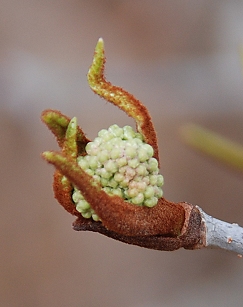
Rusty Blackhaw Viburnum bud
Rusty blackhaw viburnum is one of the most beautiful of the native shrubs, but it’s routinely scraped off by developers as “brush”. Here, the buds are just opening to show the bud-cluster that will be a puffball of pure white within a week. Easy to see why it acquired the name “rusty.” It’s a valuable plant for wildlife, producing tasty blue berries for birds–and nectar for the early butterflies and moths.
Read the rest of this entry »








